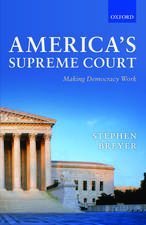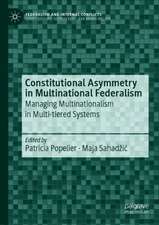The Constitution of Belgium: A Contextual Analysis: Constitutional Systems of the World
Autor Patricia Popelier, Koen Lemmensen Limba Engleză Paperback – 21 oct 2015
Din seria Constitutional Systems of the World
- 13%
 Preț: 174.07 lei
Preț: 174.07 lei - 38%
 Preț: 134.64 lei
Preț: 134.64 lei - 23%
 Preț: 197.68 lei
Preț: 197.68 lei - 14%
 Preț: 147.59 lei
Preț: 147.59 lei - 34%
 Preț: 509.52 lei
Preț: 509.52 lei - 28%
 Preț: 374.41 lei
Preț: 374.41 lei - 40%
 Preț: 466.81 lei
Preț: 466.81 lei - 22%
 Preț: 263.72 lei
Preț: 263.72 lei - 23%
 Preț: 185.93 lei
Preț: 185.93 lei - 19%
 Preț: 166.82 lei
Preț: 166.82 lei - 23%
 Preț: 152.82 lei
Preț: 152.82 lei - 21%
 Preț: 218.26 lei
Preț: 218.26 lei - 23%
 Preț: 178.47 lei
Preț: 178.47 lei - 19%
 Preț: 303.62 lei
Preț: 303.62 lei - 18%
 Preț: 300.14 lei
Preț: 300.14 lei - 30%
 Preț: 510.03 lei
Preț: 510.03 lei - 14%
 Preț: 192.30 lei
Preț: 192.30 lei - 18%
 Preț: 304.66 lei
Preț: 304.66 lei - 23%
 Preț: 178.02 lei
Preț: 178.02 lei - 18%
 Preț: 225.31 lei
Preț: 225.31 lei - 23%
 Preț: 197.14 lei
Preț: 197.14 lei - 18%
 Preț: 180.44 lei
Preț: 180.44 lei - 18%
 Preț: 179.98 lei
Preț: 179.98 lei - 14%
 Preț: 179.00 lei
Preț: 179.00 lei - 16%
 Preț: 218.47 lei
Preț: 218.47 lei - 19%
 Preț: 184.14 lei
Preț: 184.14 lei - 18%
 Preț: 297.58 lei
Preț: 297.58 lei - 16%
 Preț: 218.00 lei
Preț: 218.00 lei - 18%
 Preț: 232.54 lei
Preț: 232.54 lei - 23%
 Preț: 171.85 lei
Preț: 171.85 lei - 18%
 Preț: 225.49 lei
Preț: 225.49 lei - 14%
 Preț: 185.93 lei
Preț: 185.93 lei - 13%
 Preț: 230.79 lei
Preț: 230.79 lei - 13%
 Preț: 186.10 lei
Preț: 186.10 lei - 19%
 Preț: 179.10 lei
Preț: 179.10 lei -
 Preț: 223.20 lei
Preț: 223.20 lei - 18%
 Preț: 180.44 lei
Preț: 180.44 lei -
 Preț: 217.09 lei
Preț: 217.09 lei - 18%
 Preț: 186.35 lei
Preț: 186.35 lei
Preț: 186.35 lei
Preț vechi: 228.44 lei
-18% Nou
Puncte Express: 280
Preț estimativ în valută:
35.66€ • 37.43$ • 29.60£
35.66€ • 37.43$ • 29.60£
Carte tipărită la comandă
Livrare economică 10-24 aprilie
Preluare comenzi: 021 569.72.76
Specificații
ISBN-13: 9781849464154
ISBN-10: 1849464154
Pagini: 312
Dimensiuni: 138 x 216 x 10 mm
Greutate: 0.41 kg
Editura: Bloomsbury Publishing
Colecția Hart Publishing
Seria Constitutional Systems of the World
Locul publicării:London, United Kingdom
ISBN-10: 1849464154
Pagini: 312
Dimensiuni: 138 x 216 x 10 mm
Greutate: 0.41 kg
Editura: Bloomsbury Publishing
Colecția Hart Publishing
Seria Constitutional Systems of the World
Locul publicării:London, United Kingdom
Caracteristici
In this comprehensive textbook, the institutional structure and the principles governing the Belgian constitutional system are explained in the light of its historical, demographic and political context.
Notă biografică
Patricia Popelier is Professor of Constitutional Law at the University of Antwerp.Koen Lemmens is Associate Professor of Human Rights at the Catholic University of Louvain.
Cuprins
1. CONSTITUTIONAL PRINCIPLES: A HISTORICAL AND SOCIOLOGICAL ACCOUNT PART I: THE HISTORICAL BACKGROUND OF THE CONSTITUTION PART II: NATIONAL SOVEREIGNTY AND A 'MUZZLED' KING A. National Sovereignty B. A Parliamentary Monarchy: The King ' s Powers Limited PART III: THE TRANSFORMATION OF THE UNITARY DECENTRALISED STATE INTO A FEDERAL STATE: SIX IMPORTANT STATE REFORMS A. Before 1970 B. The 1970 Reform: The Foundations of the New State C. The 1980 Reform: The Regions Come Alive D. The 1988 Reform: The Creation of the Brussels-Capital Region E. The 1993 Reform: Federalism at Last F. The 2001 - 2003 Reform: Without Modifying the Constitution G. The 2012 - 2013 Reform: A Long Journey to . Conclusion Further Reading 2. THE FUNDAMENTAL PRINCIPLES OF THE BELGIAN CONSTITUTION PART I: CONSTITUTIONALISM A. The Constitution B. The Rechtsstaat C. The Separation of Powers PART II: THE DEMOCRATIC PRINCIPLE A. Constitutional Concepts of Democracy B. Challenges PART III: FEDERALISM AND MULTILEVEL GOVERNANCE Conclusion Further Reading 3. FEDERALISM AND THE MULTILEVEL STRUCTURE OF GOVERNMENT PART I: FEATURES A. General Features B. Particular Features C. Future Prospects PART II: ALLOCATION OF COMPETENCES A. Residual Powers B. Techniques for the Allocation of Powers C. Processes for Changing the Distribution of Powers PART III: SUBNATIONAL CONSTITUTIONALISM PART IV: BRUSSELS PART V: BELGIUM IN THE EUROPEAN UNION A. Constitutional Hubs for European Integration B. Capturing Tri-Level Dynamics in the Constitutional System Conclusion Further Reading 4. THE LEGISLATIVE BRANCH PART I: PARLIAMENTARY GOVERNMENT AND POLITICAL PARTIES A. The Crucial Role of Political Parties in the Belgian System of Parliamentary Government B. Status and Financing of Political Parties PART II: THE ELECTORAL SYSTEM A. Voting Rights and Quotas B. Principles of the Electoral System PART III: BICAMERALISM PART IV: FUNCTIONS A. The Legislative Function B. The Power of the Purse C. Parliamentary Control D. Foreign Affairs and Military Matters PART V: MEMBERS OF PARLIAMENT: LEGAL STATUS PART VI: DISSOLUTION OF PARLIAMENT PART VII: PARLIAMENT AND EUROPEANINTEGRATION Conclusion Further Reading 5. THE EXECUTIVE POWER AND ADMINISTRATION PART I: THE KING AS HEAD OF THE EXECUTIVE POWER PART II: GOVERNMENT AS THE HEART OF THE EXECUTIVE A. Council of Ministers (The Federal Cabinet) B. Council of Ministers and State Secretaries C. The Inner Cabinet ( Het Kernkabinet ) D. The Crown Council PART III: COMPETENCES A. Nomination of Ministers, Secretaries of State and Civil Servants B. Execution of Laws C. Foreign Affairs D. Defence PART IV: LEGAL STATUS A. The King B. The Ministers and the Secretaries of State PART V: POLITICAL AND LEGAL ACCOUNTABILITY PART VI: ADMINISTRATION AND PUBLIC SERVICES PART VII: CURRENT AFFAIRS Conclusion Further Reading 6. THE PLURALISTIC JUDICIAL SYSTEM AND THE CONSTITUTIONAL COURT PART I: CONSTITUTIONAL PRINCIPLES A. Constitutional Principles and the Court System B. Constitutional Principles of Due Process PART II: THE CONSTITUTIONAL COURT A. Establishment and Development B. Composition C. The Powers and Procedures of the Court D. The Role of the Constitutional Court PART III: THE COURTS AND EUROPEAN INTEGRATION Conclusion Further Reading 7. FUNDAMENTAL RIGHTS PART I: AN OUTDATED CATALOGUE OF FUNDAMENTAL RIGHTS? A. The Emergence of New Rights B. The Internationalisation of Fundamental Rights C. Horizontal Effect of Fundamental Rights PART II: THE BELGIAN FORMAL APPROACH TO FUNDAMENTAL RIGHTS A. A Legal Basis for Restrictions Through Acts of Parliament B. No Prior Intervention C. Looking at Fundamental Rights Through the Prism of Equality PART III: THE EUROPEAN CONTRIBUTION TO FUNDAMENTAL RIGHTS A. The European Convention on Human Rights B. EU Law PART IV: CONCURRING FUNDAMENTAL RIGHTS PART V: THE PROBLEM OF LINGUISTIC RIGHTS: A CASUS BELLI ? PART VI: NEW CHALLENGES TO FUNDAMENTAL RIGHTS PROTECTION Conclusion Further Reading CONCLUSION: NO FUTURE FOR BELGIUM OR A BELGIAN BLUEPRINT FOR THE FUTURE? ECONOMIC CONTEXT DEMOGRAPHIC CONTEXT EUROPEAN INTEGRATION A FUTURE FOR BELGIUM?
Descriere
In this book, the institutional structure and the principles governing the Belgian constitutional system are explained in the light of its historical, demographic and political context.























